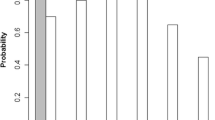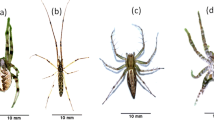Summary
Prey capture rate, food consumption, and diet composition of all developmental stages of the funnelweb spider Agelena limbata were estimated in woody and open habitats by a sight-count method. Prey availability was evaluated on the basis of two indices, i.e. the ratios of daily food consumption to dry weight of predator and to daily standard metabolic rate. These indices varied seasonally and between instars in this spider. Comparison of these indices between arthropod predators suggests that A. limbata live under conditions of relatively limited food supply. In the open habitat, the spiders reduced foraging activities to avoid heat stress at midday in summer because the sheet web was exposed to the direct rays of the sun and its temperature exceeded 40°C. The daily food consumption of adult spiders in the open habitat was about half of that in the woody habitat. The lower rate of energy intake of spiders in the open habitat may cause the observed smaller size of adults and lower fecundity. A. limbata captured a great range of prey comprising ten orders of arthropods and ate chemically defended insects, e.g. stink bugs, lady beetles, and ants which were rejected by many spiders. This generalistic foraging may be associated with limited and heterogeneous food supply in this spider.
Similar content being viewed by others
References
Anderson JF (1970) Metabolic rates of spiders. Comp Biochem Physiol 33:51–72
Anderson JF (1974) Responses to starvation in the spiders Lycosa lenta Hentz and Filistata hibernalis (Hentz). Ecology 55:576–585
Anderson JF, Prestwich KN (1982) Respiratory gas exchange in spiders. Physiol Zool 55:72–90
Avery RA (1971) Estimates of food consumption by the lizard Lacerta vivipara Jacquin. J Anim Ecol 40:351–365
Baskerville GL (1972) Use of logarithmic regression in the estimation of plant biomass. Can J Forest Res 2:49–53
Foelix RF (1982) Biology of Spiders. Harvard Univ Press, Cambridge, Massachusetts and London
Greenstone MH, Bennett AF (1980) Foraging strategy and metabolic rate in spiders. Ecology 61:1255–1259
Higashi K (1973) Estimation of the food consumption for some species of dragonflies I. Estimation by observation for the frequency of feeding flights of dragonflies (in Japanese). Rep Ebino Biol Lab, Kyushu Univ 1:119–129
Higashi K, Nomakuchi S, Maeda M, Yasuda T (1979) Daily food consumption of Mnais pruinosa Selys (Zygoptera: Calopterygidae). Odonatologica 8:159–169
Humphreys WF (1975a) The food consumption of a wolf spider Geolycosa godeffroyi (Araneae: Lycosidae) in the Australian Capital Territory. Oecologia 18:343–358
Humphreys WF (1975b) The respiration of Geolycosa godeffroyi (Araneae: Lycosidae) under conditions of constant and cyclic temperature. Physiol Zool 48:269–281
Itô Y (1964) Preliminary studies on the respiratory energy loss of the spider, Lycosa pseudoannulata. Res Popul Ecol 6:13–21
Kiritani K, Kawahara S, Sasaba T, Nakasuji F (1972) Quantitative evaluation of predation by spiders on the green rice leafhopper, Nephotettix cincticeps Uhler, by a sight-count method. Res Popul Ecol 13:187–200
Matsura T (1981) Responses to starvation in a mantis, Paratenodera angustipennis (S.). Oecologia 50:291–295
Matsura T, Nagai S (1983) Estimation of prey consumption of a mantid, Paratenodera angustipennis (S.) in a natural habitat. Res Popul Ecol 25:298–308
Miyashita K (1968a) Quantitative feeding biology of Lycosa T-insignita Boes. et Str. (Araneae: Lycosidae). Bull Natl Inst Agr Sci C No.22:329–344
Miyashita K (1968b) Growth and development of Lycosa T-insignita Boes. et Str. (Araneae: Lycosidae) under different feeding conditions. Appl Ent Zool 3:81–88
Miyashita K (1969) Effects of locomotory activity, temperature and hunger on the respiratory rate of Lycosa T-insignita Boes. et Str. (Araneae: Lycosidae). Appl Ent Zool 4:105–113
Moulder BC, Reichle DE (1970) Significance of spider predation in energy dynamics of forest floor arthropod communities. Ecol Monogr 42:473–498
Riechert SE (1978) Energy-based territoriality in populations of the desert-spider, Agelenopsis aperta (Gertsch): Symp Zool Soc Lond No.42:211–222
Riechert SE (1979) Games spiders play II. Resource assessment strategies. Behav Ecol Sociobiol 6:121–128
Riechert SE, Luczak J (1982) Spider foraging: Behavioral responses to prey. In: Witt PN, Rovner JS (eds) Spider communication: Mechanisms and ecological significance. Princeton Univ Press, Princeton, New Jersey, pp. 353–385
Riechert SE, Tracy CR (1975) Thermal balance and prey availability: Bases for a model relating web-site characteristics to spider reproductive success. Ecology 56:265–285
Robinson MH, Robinson B (1970) Prey caught by a sample population of the spider Argiope argentata (Araneae: Araneidae) in Panama: A year's census data. Zool J Linn Soc 49:345–357
Sprugel DG (1989) Correction for bias in log-transformed allometric equations. Ecology 64:209–210
Tanaka K (1989) Energetic cost of web construction and its effect on web relocation in the web-building spider Agelena limbata. Oecologia 81:459–464
Tanaka K, Itô Y (1982) Decrease in respiratory rate in a wolf spider, Pardosa astrigera (L. Koch), under starvation. Res Popul Ecol 24:360–374
Tanaka K, Itô Y, Saito T (1985) Reduced respiratory quotient by starvation in a wolf spider, Pardosa astrigera (L. Koch). Comp Biochem Physiol 80A:415–418
Townsend CR, Hildrew AG (1980) Foraging in a patchy environment by a predatory net-spinning caddis larva: A test of optimal foraging theory. Oecologia 47:219–221
Wise DH (1975) Food limitation of the spider. Linyphia marginata: Experimental field studies. Ecology 56:637–646
Wise DH (1979) Effects of an experimental increase in prey abundance upon the reproductive rates of two orb-weaving spider species (Araneae: Araneidae). Oecologia 41:289–300
Wise DH (1983) Competitive mechanisms in a food-limited species: Relative importance of interference and exploitative interactions among labyrinth spiders (Araneae: Araneidae). Oecologia 58:1–9
Author information
Authors and Affiliations
Rights and permissions
About this article
Cite this article
Tanaka, K. Food consumption and diet composition of the web-building spider Agelena limbata in two habitats. Oecologia 86, 8–15 (1991). https://doi.org/10.1007/BF00317382
Received:
Accepted:
Issue Date:
DOI: https://doi.org/10.1007/BF00317382




